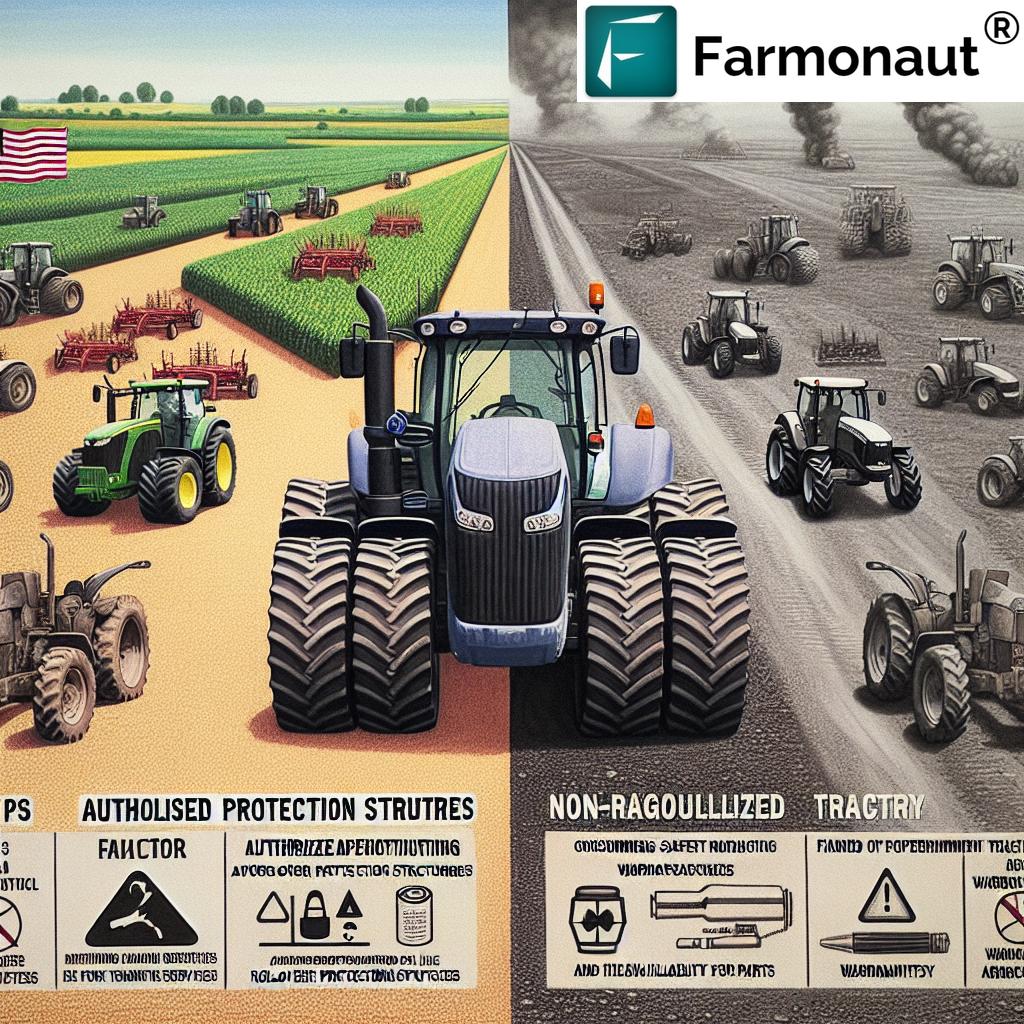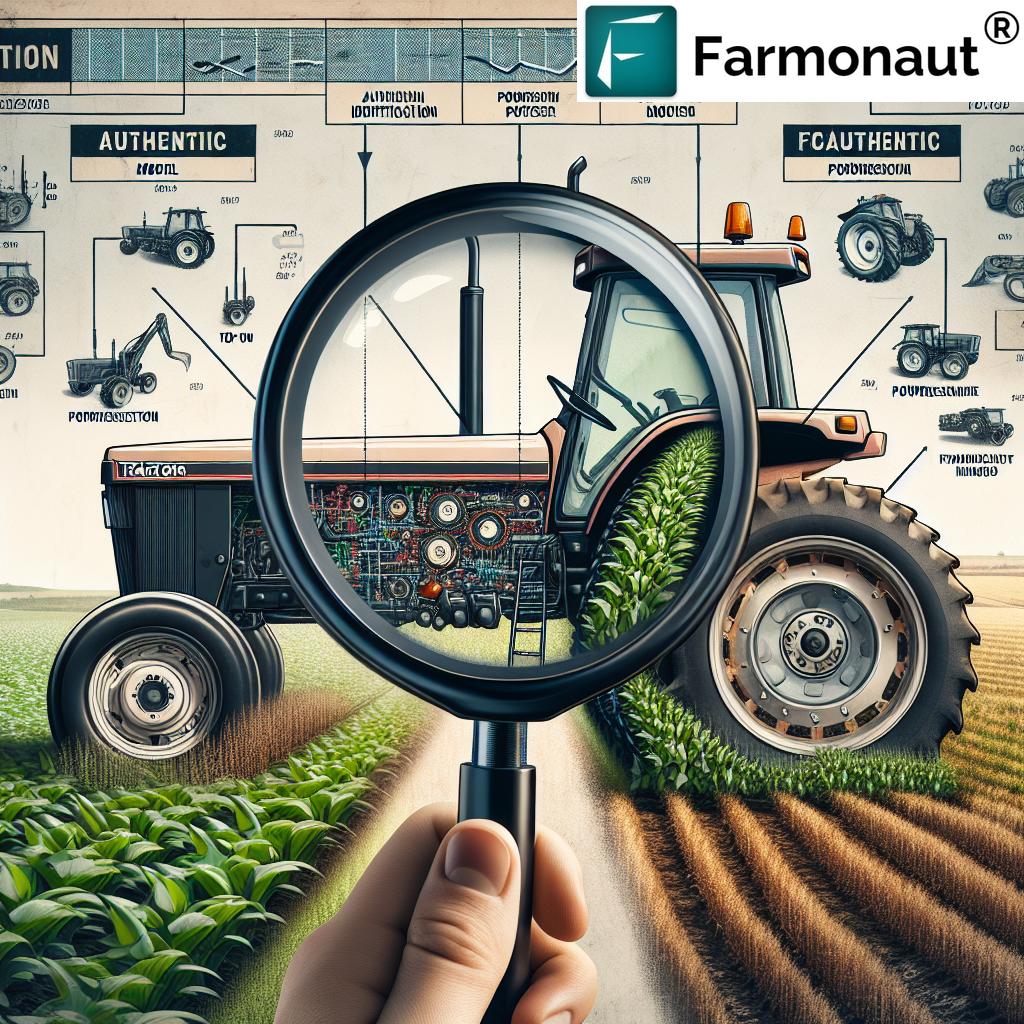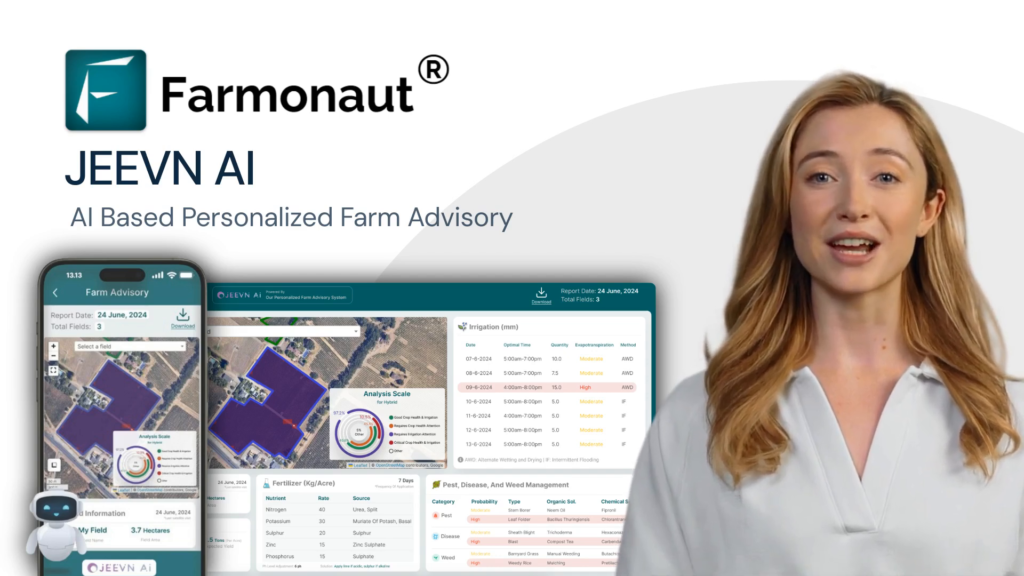Gray Market Tractors: Understanding the Risks and Regulations in U.S. Agricultural Equipment Imports
“Since 1997, PTO horsepower regulations have significantly impacted the U.S. agricultural equipment import industry, affecting thousands of tractors annually.”
In the ever-evolving landscape of American agriculture, the issue of gray market tractors has become a significant concern for farmers, dealers, and industry regulators alike. As we delve into this complex topic, we’ll explore the risks, regulations, and implications surrounding these unauthorized imports, particularly focusing on Japanese models entering the United States market.
At Farmonaut, we understand the importance of making informed decisions when it comes to agricultural equipment. While our expertise lies in providing cutting-edge satellite-based farm management solutions, we recognize the need for farmers to be well-informed about all aspects of their operations, including the machinery they use.

What Are Gray Market Tractors?
Gray market tractors are agricultural equipment imported into the United States through unauthorized channels. These tractors, often Japanese models, are typically manufactured for use in other countries and do not comply with U.S. safety and emissions standards. The term “gray market” refers to the legal ambiguity surrounding their importation and sale.
While these tractors may seem like a bargain at first glance, they pose significant risks to buyers and operators. Let’s explore why these imports have become a contentious issue in the U.S. agricultural sector.
The Risks of Purchasing Gray Market Tractors
- Safety Concerns: Many gray market tractors lack crucial safety features required by U.S. regulations, such as Rollover Protective Structures (ROPS) and seatbelts.
- Warranty Issues: Unauthorized imports often come without valid manufacturer warranties, leaving buyers unprotected in case of malfunction or damage.
- Parts Availability: Obtaining replacement parts for these models can be challenging, as they may not be readily available in the U.S. market.
- Compliance Problems: Gray market tractors may not meet U.S. emissions standards, potentially leading to legal issues for owners.
- Resale Difficulties: The unauthorized nature of these imports can significantly impact their resale value and marketability.
To better understand the gravity of this issue, let’s take a closer look at the key differences between authorized and gray market tractors:
| Feature | Authorized Tractors | Gray Market Tractors |
|---|---|---|
| Safety Features (ROPS, Seatbelts) | ✓ (Standard) | ✗ (Often Missing) |
| Warranty Coverage | ✓ (Full Manufacturer Warranty) | ✗ (Limited or None) |
| Parts Availability | ✓ (Readily Available) | ✗ (Limited or Difficult to Obtain) |
| U.S. Regulatory Compliance | ✓ (Fully Compliant) | ✗ (Often Non-Compliant) |
| PTO Horsepower Standards | ✓ (Meets U.S. Standards) | ✗ (May Not Meet Standards) |
| Estimated Resale Value | High | Low |
| Dealer Support | ✓ (Full Support Network) | ✗ (Limited or No Support) |
| Legal Implications | ✓ (No Issues) | ✗ (Potential Legal Risks) |
As we can see, the differences between authorized and gray market tractors are significant and can have far-reaching consequences for farmers and agricultural operations.
The Impact of PTO Horsepower Regulations
One of the key factors in the gray market tractor issue is the Power Take-Off (PTO) horsepower regulations implemented in the United States. In 1997, the U.S. government introduced stricter standards for PTO horsepower, which had a profound impact on the agricultural equipment import industry.
These regulations were designed to ensure that tractors sold in the U.S. met specific safety and performance standards. However, they also created a situation where many Japanese tractor models, which were popular among American farmers due to their reliability and compact size, could no longer be legally imported.
The implementation of these regulations led to:
- A significant reduction in the number of tractor models available for import
- Increased demand for pre-1997 Japanese tractors, which were not subject to the new regulations
- The rise of gray market imports as a way to circumvent these restrictions
At Farmonaut, we understand the importance of staying informed about such regulatory changes. While our focus is on providing advanced satellite-based farm management solutions, we recognize that these regulations have a significant impact on our users’ equipment choices and operational decisions.
Identifying Gray Market Tractors
For farmers and equipment buyers, knowing how to identify potentially problematic gray market tractors is crucial. Here are some key indicators to look out for:
- Model Identification: Gray market tractors often have model numbers that don’t match those of authorized U.S. imports. Research the specific model numbers for the brand you’re interested in.
- Operator Manual Discrepancies: Check the operator’s manual. If it’s not in English or contains information inconsistent with U.S. standards, it may be a gray market tractor.
- Missing Safety Features: Look for standard safety features like ROPS and seatbelts. Their absence is a red flag.
- Unusual Specifications: If the tractor’s specifications seem odd for the U.S. market (e.g., metric measurements only), it might be a gray market import.
- Lack of Compliance Stickers: Authorized tractors will have stickers indicating compliance with U.S. regulations. The absence of these is suspicious.
By being vigilant and informed, buyers can protect themselves from the risks associated with unauthorized imports.
The Role of International Trade Commission Rulings
The International Trade Commission (ITC) has played a significant role in shaping the landscape of agricultural equipment imports in the United States. Since the late 1990s, several key rulings have had far-reaching effects on the industry:
- 1997 Ruling: This decision effectively banned the importation of certain Japanese tractors that didn’t meet U.S. standards.
- Subsequent Rulings: The ITC has continued to refine and enforce regulations, impacting both importers and domestic manufacturers.
These rulings have:
- Strengthened the position of authorized dealers
- Increased focus on compliance with U.S. safety and emissions standards
- Created challenges for those seeking to import foreign-market tractors
“Unauthorized Japanese tractor imports often lack crucial safety features like ROPS and seatbelts, potentially endangering thousands of U.S. farmers.”
The Importance of Purchasing from Authorized Dealers
Given the risks associated with gray market tractors, we at Farmonaut strongly recommend purchasing agricultural equipment from authorized dealers. Here’s why:
- Guaranteed Compliance: Authorized dealers sell tractors that meet all U.S. safety and emissions standards.
- Warranty Protection: You’ll receive full manufacturer warranty coverage, ensuring peace of mind.
- Parts and Service: Access to genuine parts and expert service is guaranteed.
- Legal Assurance: No risk of legal issues related to non-compliant equipment.
- Resale Value: Authorized tractors typically maintain higher resale values.
While our expertise at Farmonaut lies in satellite-based farm management, we understand the importance of reliable equipment in maximizing the benefits of our technology. Our solutions, such as crop health monitoring and AI-based advisory systems, work best when paired with compliant, well-maintained machinery.
Explore Farmonaut’s API for advanced agricultural insights
Consumer Protection in Agricultural Machinery Purchases
Protecting consumers in the agricultural machinery market is crucial. Here are some key aspects of consumer protection to be aware of:
- Lemon Laws: Some states have lemon laws that apply to farm equipment, providing recourse for defective machinery.
- Disclosure Requirements: Dealers are often required to disclose certain information about the equipment they sell, including its origin and compliance status.
- Consumer Education: Many agricultural organizations provide resources to help farmers make informed purchasing decisions.
At Farmonaut, we believe in empowering farmers with information. While our focus is on providing cutting-edge farm management tools, we encourage our users to apply the same level of diligence in their equipment purchases as they do in their crop management strategies.
Check out our API Developer Docs for seamless integration

The Impact on the U.S. Agricultural Industry
The issue of gray market tractors has had a significant impact on the U.S. agricultural industry:
- Market Dynamics: The restrictions on imports have influenced the availability and pricing of certain tractor models.
- Dealer Networks: Authorized dealers have seen increased protection, but also face competition from gray market sellers.
- Farmer Choices: While regulations limit some options, they also ensure access to safer, compliant equipment.
- Industry Innovation: Domestic manufacturers have had to innovate to meet the demand for compact, efficient tractors previously filled by Japanese imports.
These changes have reshaped the agricultural equipment landscape in the United States, influencing everything from farm operations to industry regulations.
Legal Implications for Buyers and Sellers
The legal landscape surrounding gray market tractors is complex and carries significant implications for both buyers and sellers:
- For Buyers:
- Potential fines for operating non-compliant equipment
- Insurance complications in case of accidents
- Difficulty in reselling the equipment
- For Sellers:
- Risk of legal action from manufacturers for trademark infringement
- Potential civil and criminal penalties for selling non-compliant equipment
- Liability issues if sold equipment is involved in accidents
It’s crucial for all parties involved in the sale or purchase of agricultural equipment to be fully aware of these legal risks.
The Future of Agricultural Equipment Imports
As we look to the future, several trends are likely to shape the landscape of agricultural equipment imports:
- Increased Globalization: Despite current restrictions, the global nature of agriculture may lead to more standardized regulations across countries.
- Technological Advancements: New technologies may make it easier to retrofit or adapt foreign tractors to meet U.S. standards.
- Shift in Consumer Preferences: Growing awareness of safety and environmental concerns may further reduce demand for gray market tractors.
- Policy Changes: Future trade agreements and policy shifts could alter the current regulatory landscape.
At Farmonaut, we’re committed to staying at the forefront of agricultural technology. Our satellite-based solutions are designed to work with a wide range of equipment, helping farmers maximize efficiency regardless of the specific machinery they use.
Making Informed Decisions: A Guide for Buyers
For those in the market for agricultural equipment, here are some key steps to ensure you make an informed decision:
- Research Thoroughly: Understand the specific models approved for sale in the U.S.
- Verify Compliance: Ensure the tractor meets all relevant U.S. safety and emissions standards.
- Check Documentation: Review all paperwork, including warranties and service records.
- Inspect in Person: Whenever possible, physically inspect the tractor before purchase.
- Consult Experts: Seek advice from authorized dealers or agricultural equipment specialists.
- Consider Long-Term Costs: Factor in potential maintenance and parts availability issues.
- Understand the Risks: Be aware of the legal and safety implications of purchasing gray market equipment.
By following these steps, buyers can protect themselves from the pitfalls associated with unauthorized imports while ensuring they acquire equipment that meets their needs and complies with all relevant regulations.
Conclusion: Navigating the Complex World of Farm Equipment Purchases
The issue of gray market tractors in the United States is a complex one, with significant implications for farmers, dealers, and the agricultural industry as a whole. While the allure of potentially lower prices may be tempting, the risks associated with unauthorized imports far outweigh any short-term benefits.
By understanding the regulations, being aware of the risks, and making informed decisions, farmers can ensure they invest in equipment that is not only efficient and reliable but also safe and compliant with all relevant standards. This approach not only protects individual farmers but also contributes to the overall safety and integrity of the U.S. agricultural sector.
At Farmonaut, while our primary focus is on providing cutting-edge satellite-based farm management solutions, we recognize the importance of reliable, compliant equipment in maximizing the benefits of our technology. We encourage all our users to approach their equipment purchases with the same level of diligence and forward-thinking that they apply to their crop management strategies.
Remember, a well-informed decision today can lead to years of safe, efficient, and profitable farming. Stay informed, prioritize safety and compliance, and leverage the best technologies available to take your agricultural operations to new heights.
FAQ Section
Q: What exactly is a gray market tractor?
A: A gray market tractor is an agricultural vehicle imported into the United States through unauthorized channels. These tractors are typically manufactured for use in other countries and often do not comply with U.S. safety and emissions standards.
Q: Why are gray market tractors cheaper than authorized imports?
A: Gray market tractors are often cheaper because they bypass official import channels and may not include the safety features or modifications required for U.S. compliance. This can lead to lower upfront costs but potentially higher long-term expenses and risks.
Q: What are the main risks of buying a gray market tractor?
A: The main risks include lack of warranty coverage, difficulty obtaining parts, potential legal issues due to non-compliance with U.S. regulations, safety concerns due to missing features like ROPS, and lower resale value.
Q: How can I identify a gray market tractor?
A: Look for inconsistencies in model numbers, non-English operator manuals, missing U.S. compliance stickers, and the absence of standard safety features like ROPS and seatbelts.
Q: Are there any legal consequences for owning a gray market tractor?
A: Yes, there can be legal consequences. You may face fines for operating non-compliant equipment, encounter insurance complications, and have difficulty reselling the tractor.
Q: How have PTO horsepower regulations affected tractor imports?
A: PTO horsepower regulations implemented in 1997 significantly restricted the import of certain Japanese tractor models, leading to increased demand for pre-1997 tractors and the rise of gray market imports.
Q: What should I do if I unknowingly purchased a gray market tractor?
A: Consult with a legal expert specializing in agricultural equipment. You may need to explore options for bringing the tractor into compliance or potentially returning it to the seller.
Q: How do gray market tractors impact authorized dealers?
A: Gray market tractors create unfair competition for authorized dealers who invest in compliance and customer support. They can also damage brand reputation if customers associate poor experiences with the manufacturer.
Q: Are there any situations where buying a gray market tractor might be acceptable?
A: While generally not recommended, in rare cases, such as for parts or restoration projects, a gray market tractor might be considered. However, it’s crucial to understand that such tractors cannot be legally operated on U.S. farms without significant modifications.
Q: How can I ensure I’m buying a fully compliant tractor?
A: Purchase from authorized dealers, request documentation of U.S. compliance, and verify the tractor’s history and specifications. When in doubt, consult with agricultural equipment experts or legal professionals.
















